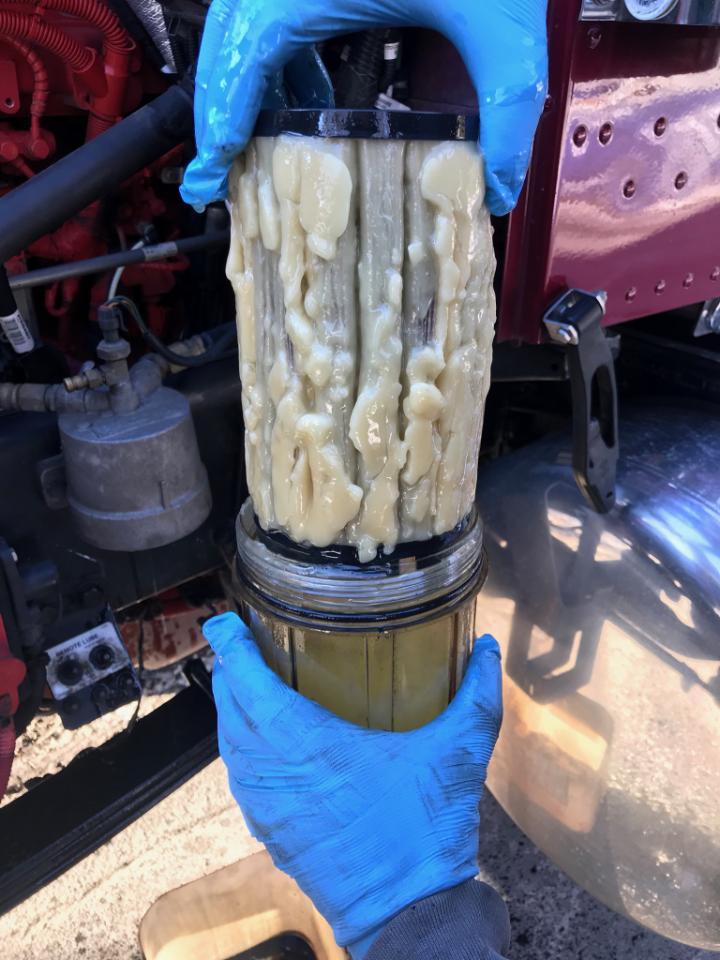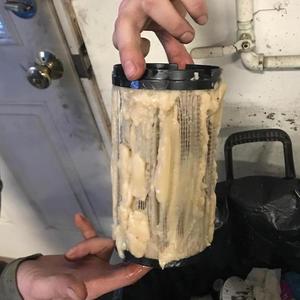'White grease' suffocating fuel filters not biodiesel-related




Photo: Advanced Fuel Solutions
January 18, 2018
BY Paul Nazzaro
The historic cold snap that gripped New England and the Mid-Atlantic to kick off the New Year challenged fuel handlers throughout the region, causing sporadic operational issues for diesel fuel and heating oil professionals, along with their customers. One phenomenon our team has been seeing more of recently is the formation of a white grease-like substance that suffocates fuel filters and doesn’t melt at room temperature—as one might expect—nor does it have anything to do with biodiesel.
With regional cloud points ranging from 9 to 15 degrees Fahrenheit, this substance would form after a delivery truck offloaded the fuel from its cold aluminum tank into above ground storage tanks subjected to ambient temperatures as low as 2 F. The fuel would then be pumped into diesel vehicles, where it was left to sit idle and unprotected from the elements over the long holiday weekend.
It’s important to note here that even if this fuel were properly winterized and rated to operate down to a minus 20 F cold filter plugging point (CFPP), without garaging the trucks, heat taping the filters and saddle tank, draining water from the saddle tanks (via its petcock), or maintaining the water-fuel separators, it would still likely be compromised while sitting in the truck filter’s housing for such a long duration under such extreme conditions. So, when it came time to operate the trucks, it’s not surprising that some fleets were finding a white grease-like substance suffocating their filters.
Advertisement
When something like this occurs, we typically tell our clients to remove their filters from the housings and bring them into the garage. If after 20 minutes they see a pool of water under the filter, moisture is contaminating their fuel. If the material begins to melt, slowly sliding off the filter media, and looks creamy, it’s probably paraffin. If the material does not come off the filter, however, two additional scenarios are possible.
The first scenario is when biodiesel is present, and moisture extracts monoglycerides out from the fuel, resulting in wax buildup on the filters. The second, less commonly recognized scenario, happens in No. 2 ULSD, which is a mixture of n-paraffin hydrocarbons (typically C8 to C32). The longest chain length hydrocarbons, greater than C20, have melting points above 100 F. These paraffins are only liquid in diesel fuel at room temperature due to the lighter-chain paraffins (less than C16). As the fuel is exposed to lower temperatures, these longer-chain hydrocarbons start to come out of solution and get caught on the filter, eventually blinding it. The lighter ends remain a liquid and pass through the filter or get trapped in the filter canister. These liquids are typically what our team finds in the container when it arrives at our testing facilities. Without a strong solvent such as xylene, the heavier-end paraffin that blinds the filter will not go back into solution. In the absence of higher temperatures, diesel fuel itself doesn’t have enough solvency power to dissolve the wax on the filter. Heavy, waxy fuels have more of these higher-chain hydrocarbons, which is why our region has been seeing more of this “white grease” that doesn’t melt at room temperatures. Under these circumstances, it is not biodiesel related, just long-chain ULSD hydrocarbons—something that your regional suppliers can’t control.
With this in mind, who is responsible for ensuring that diesel fuel performs optimally in the customer’s tank? The truth is, everyone in the supply chain is responsible—including the end users themselves. Whoever is treating the fuel with additives and kerosene is responsible for proper and accurate blending. The company lifting the fuel from the terminal is responsible for making sure that the delivery truck they are using is, to the best of their ability, kept clean and dry. (They should be sticking the customer’s tank before and after deliveries as well.) The customer needs to understand the operability points of the fuel as well as the seasonal temperatures to which the fuel will be subjected. If the fuel is rated for a specific CFPP, this is a benchmark, but when it leaves the terminal and is introduced into another diesel fuel (even if it is from the same terminal), the fuels then become different from what was lifted from the rack. Know what is in the tank, understand what you are buying, and plan accordingly with preventative fuel quality maintenance strategies. Clean, dry fuel that is formulated to perform in cold weather climates is a responsibility to be shared by all.
Author: Paul Nazzaro
Advertisement
Founder and President, Advanced Fuel Solutions Inc.
978-258-8360
paulsr@yourfuelsolution.com
*Editor’s Note: This article was originally published on Advanced Fuel Solutions’ website and is republished on BiodieselMagazine.com with permission from the company.
Related Stories
Metro Ports on April 8 announced significant environmental milestone in its voluntary efforts to reduce greenhouse gas emissions. By switching to renewable diesel, the organization reduced its carbon emissions by 85%.
The Michigan Advanced Biofuels Coalition and Green Marine are partnering to accelerating adoption of sustainable biofuels to improve air quality and reduce GHG emissions in Michigan and across the Great Lakes and St. Lawrence Seaway.
A small but increasing amount of biodiesel in the United States is consumed in the residential, commercial, and electric power sectors, according to new estimates now published in the U.S. EIA’s State Energy Data System.
IAG and Microsoft are extending their 2023 co-funded purchase agreement for SAF by five years. The SAF used under the agreement will be produced by Phillips 66’s Humberside refinery and LanzaJet’s facility in the U.S.
Neste and DB Schenker, a logistics service provider, have collaborated to work towards expanding DB Schenker’s adoption of Neste MY Renewable Diesel in Asia-Pacific. DB Schenker trialed the fuel from December 2024 to February 2025 in Singapore.
Upcoming Events










